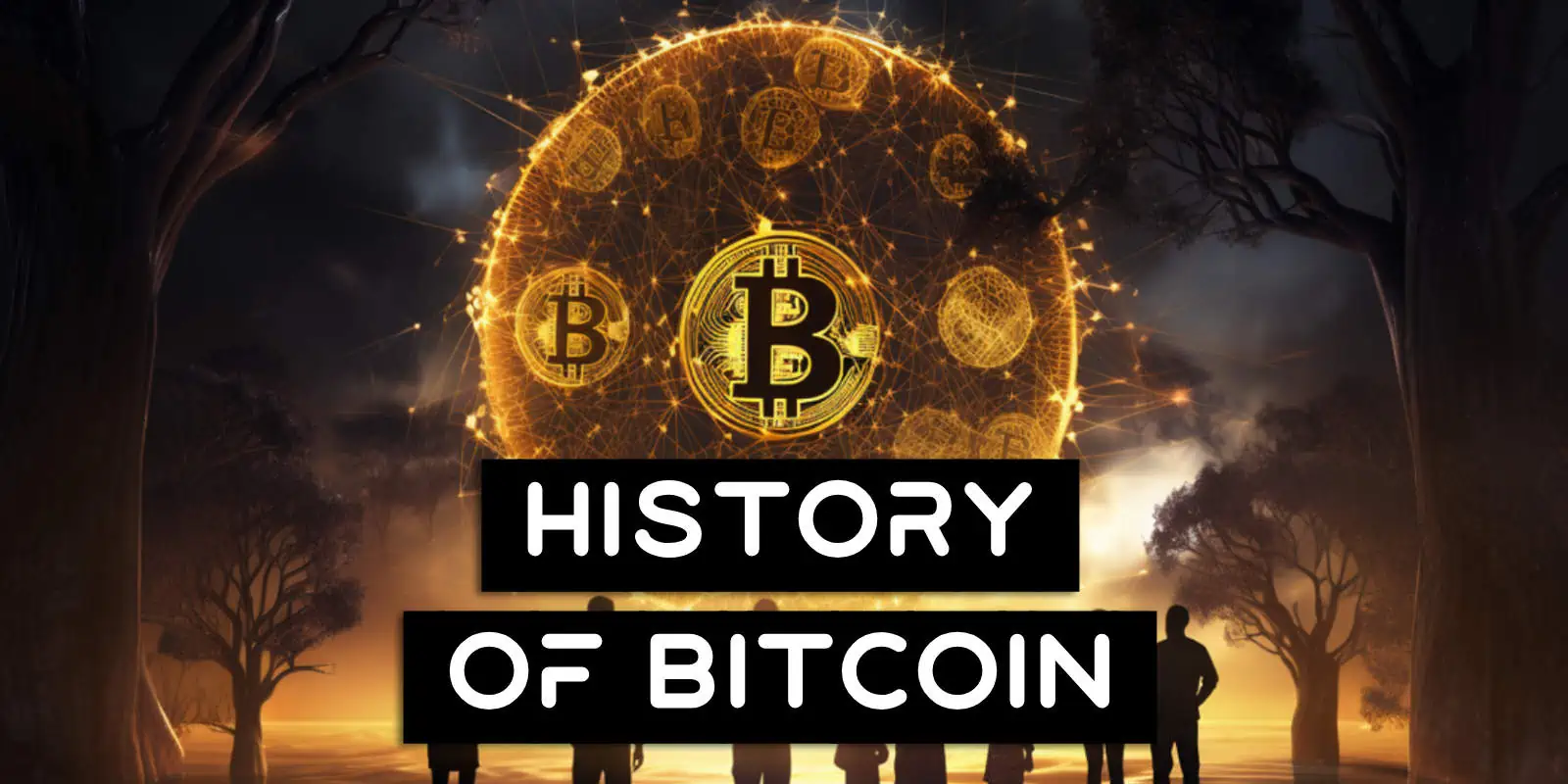While October 31st, 2008 might be when Satoshi originally published the Bitcoin Whitepaper, there’s much more to the history of Bitcoin than most know. Dating all the way back to the 1970’s, we’re going to take a thrilling journey into the many different parts including the almost dozen previously failed attempts to create “digital gold”. When did Bitcoin come out? It’s not as clear cut as you might think!
Contents
When Did Bitcoin Start?
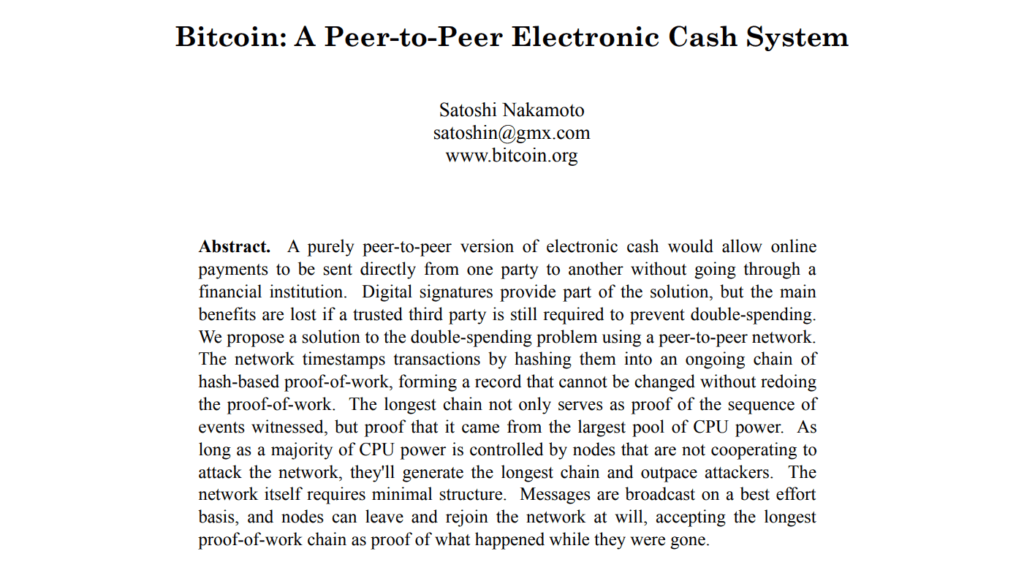
Bitcoin Was Created when Satoshi Nakamoto released the famous Bitcoin Whitepaper on a cryptography mailing list on 31st of October, 2008. On the 3rd of January, 2009 the first Bitcoin block was mined, called the “genesis block” or Block 0.
Created to be an online version of physical cash, bitcoin removed the need for trusted third parties like banks or other intermediaries like PayPal or central banks. With no central authority to control it, Bitcoin was immune to the corruption and other problems that traditional fiat currencies have previously fallen to.
The Pre History Of Bitcoin
While many think that Satoshi just pulled Bitcoin out of no where, the truth is that they were in fact standing on the shoulders of giants. The technologies that enable Bitcoin were built and worked on by hundreds of people over the course of decades prior to its inception in 2009.
From basic public and private key cryptography that has been around since the 1970’s, to multiple different forms of “digital currency” or electronic money, Satoshi was clearly building on what had come before.
Cypherpunks, a group of often anonymous individuals that advocate for the use of widespread cryptography and privacy enhancing technologies such as HTTPS or End-to-End Encryption, had been seeking a form of digital cash for many years before Bitcoin arrived.
They saw that money was quickly moving more and more into the digital realm which meant that individuals were forced to accept increased surveillance and control by the state. Digital cash was a way to bring financial privacy back to the online world, just like an individual would have when they transact with cash in the real world. Some early attempts at a digital currency include:
- DigiCash / eCash (1989)
- CyberCash (1994)
- E-gold (1996)
- Hashcash (1997)
- B-money (1998)
- WebMoney (1998)
- Liberty Reserve (2006)
- Perfect Money (2007)
- Bit Gold (2008)
All of these failed for one reason or another and helped set the stage for Bitcoin to flourish. For example, Hashcash helped lay the foundation for what we now know as Proof-of-Work (PoW) and Bitcoin Mining.
These failed attempts also show that Bitcoin wasn’t just some magic lightning bolt that came from the sky, but instead was the result of continued trial and error on the part of many different people. From cryptographers in the 70’s, to Cypherpunks in the 2000’s Bitcoin brought together dozens of unique, disparate technologies as well as brand new ideas to form a far more advanced form of money than anything humans have ever had before.
Who Invented Bitcoin?
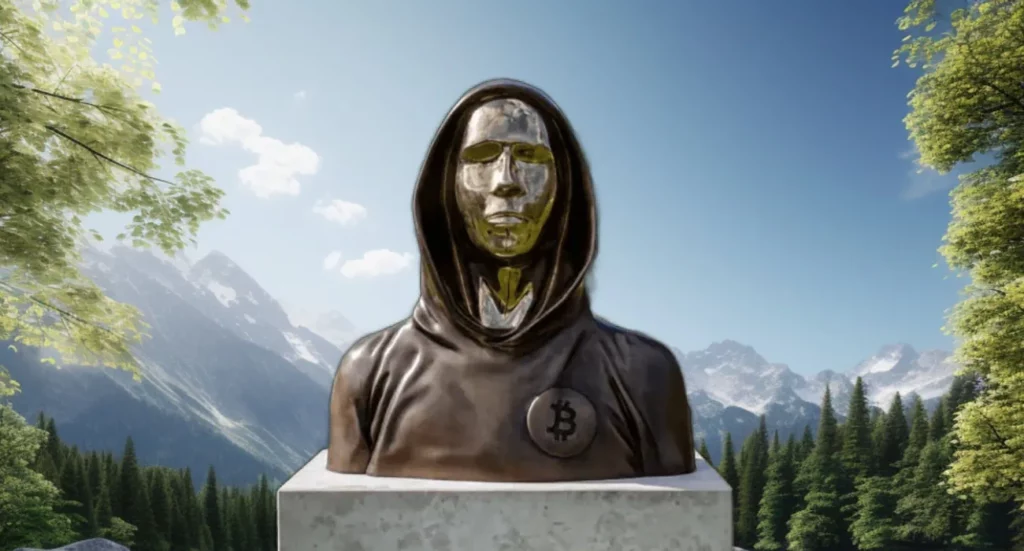
A person or group of people under the pseudonym Satoshi Nakamoto authored and released the first copy of the Bitcoin Whitepaper titled Bitcoin: A Peer To Peer Electronic Cash System. With its release they wrote:
The root problem with conventional currencies is all the trust that’s required to make it work. The central bank must be trusted not to debase the currency, but the history of fiat currencies is full of breaches of that trust.
Satoshi Nakamoto
To this day it’s still not know who this person or persons were. While many have claimed to be Satoshi, none have been able to do the one thing that would prove beyond a shadow of a doubt that they were actually them: spend Satoshi’s bitcoins.
As Satoshi started Bitcoin, they were the first to mine it, which allowed them to build up a huge amount of bitcoins from all the block rewards. It’s estimated that they mined at least 1 million bitcoins between January of 2009 and January of 2010 which would now be worth tens of billions of dollars.
Since it was originally mined all those years ago, these bitcoins have never moved. Any person wishing to prove beyond any reasonable doubt that they are Satoshi should have access to, and thus be able to spend / send those original bitcoins. So far, no one has stepped forward and proven their claim.
The Bitcoin Genesis Block
While Satoshi released the Bitcoin Whitepaper on the 31st of October, 2008, that was just the beginning. There was no active Bitcoin network at that time, as they were still writing the bitcoin software code base that would eventually become Bitcoin Core.
After the whitepaper was released, Satoshi discussed and debated the different parts of the project with a group of Cypherpunks and other computer scientists over November and December of 2008. Then on January the 3rd, 2009 they mined the very first Bitcoin block called the Genesis Block.

It took Satoshi over six days to mine this second block and in the Coinbase transaction they included in the original first block is now a famous message:
The Times 03/Jan/2009 Chancellor on brink of second bailout for banks
Bitcoin Block 0
This was a reference to the headline of the Times newspaper on that date and was a way for them to make their intentions clear. Bitcoin was a completely separate form of monetary system that was intended to save people from having to trust financial institutions such as central banks.
The Disappearing Satoshi
For a few years Satoshi spoke back and forth with developers and others on the Bitcoin forum as well as managed the general Bitcoin Core software. Bitcoin grew quickly over this short time frame and then on the 26th of April, 2011 they disappeared forever, only making one other comment in 2014 to say they weren’t Dorian Nakamoto.. Although they created the entire Bitcoin industry, they selflessly excused themselves and have never returned.
Other developers took over Bitcoin Core and the community as well as other bitcoin enthusiasts have steered it ever since, always staying true to the initial bitcoin ideology. The fact that Satoshi disappeared has actually turned out to be one of the greatest parts of Bitcoins creation for multiple reasons.
For one, it means that Bitcoin has a truly immaculate conception (of sorts). There is no head, no lead developer, no inventor, no company, no VCs, no country, no government or anything else that “heads” or “owns” bitcoin. It is as independent as gold or oil or a piece of land is.
If the true identity of Satoshi was actually known, a government or other body could have taken them down to try and stop Bitcoins rise to power. Conversely that person or persons may have done something wrong and caused the world to shun the technology. By stepping down and remaining anonymous, Satoshi ensured the future of Bitcoin would be only about Bitcoin and the technology, not them.
Mt. Gox: The First Bitcoin Exchange

After a few years of gaining traction Bitcoin began to be used more and more and on the 18th of July, 2010 the Bitcoin exchange Mt. Gox was created. Mt. Gox, which stood for Magic: The Gathering Online eXchange, was based in Tokyo and grew to eventually encompass over 70% of all bitcoin transactions.
Originally built to trade Magic: The Gathering cards, the programmer Jed McCaleb decided to alter it to instead exchange bitcoin after reading about it online. The new bitcoin exchange allowed users to view Bitcoin prices against other traditional currencies and was the first major cryptocurrency market.
After growing to be the dominant exchange it abruptly ceased operations on the 7th of February, 2014 when it halted all withdrawals. Over the following weeks Mt. Gox released statements and tried to “fix” the issue, but eventually it was revealed that they had in fact lost almost 750,000 of its customers bitcoins.
This enormous sum of bitcoin (roughly 3.5% of all bitcoin to ever exist) was valued at ~$473 million at the time and started what has unfortunately become an ongoing trend of Crypto Exchange Bankruptcies that still continues to this day.
Take this as yet another reminder to get your coins off of those exchanges!
Silk Road
In February of 2011, Ross Ulbricht under the pseudonym “Dread Pirate Roberts” started an online marketplace named Silk Road where users could buy and sell bitcoin in exchange for goods.
Silk Road was created to give people the freedom to transact, buy and sell on their own terms according to Ross, however it quickly turned into a haven for drugs, guns, money laundering and other deeply disturbing behavior.
Federal law enforcement eventually caught on, investigated the site and arrested Ulbricht on the 2nd of October, 2013. He is now serving multiple life sentences and the name Silk Road is synonymous with illegal activities and “drug money”. It’s also a huge part of why many to this day still believe the Bitcoin Myth that Bitcoin is “only used by criminals”.
Bitcoin Mining
Right from the start mining bitcoin has always been a core part of the Bitcoin network. In order to process a bitcoin transaction there needs to be work done and the mining process is not just how it’s done, but how the network as a whole is secured as well.
Throughout its history, bitcoin mining has grown to consume more hashing power and more electricity. Bitcoin Mining is a fairly nuanced topic and as such, most people who don’t properly understand it simply dismiss it as “wasteful” due to its rather large energy requirements.
This misguided notion of mining being “a waste” has been a huge part of bitcoins history for over a decade now and has only been made worse with the onslaught of Climate Change. How it works, the game theory that’s involved in it and Satoshi’s introduction of the difficulty adjustment mechanism are all pivotal in what makes bitcoin so amazing.
Originally mining was done on simple laptop CPUs as the hashing power required to mine a new block wasn’t anything huge. After a while people started using GPUs as they can calculate hashes much faster, but since around 2013 it’s only possible to mine using custom designed pieces of hardware called application-specific integrated circuit or ASICs.

In July of 2014, one of the most popular mining pools Ghash.io briefly exceeded the 51% threshold enabling it to (in theory) execute a 51% attack. This style of attack could allow them to double spend bitcoin in what’s known as the Double Spending Problem. The price of Bitcoin dropped after this new threat was circulated and when the prominent bitcoin developer Peter Todd sold half of all his bitcoin.
In March 2015, Ghash.io was hit with a DDoS attack which resulted in them ceasing mining activity by the end of 2015. Since then, no other miner or mining pool have ever gained a greater than 51% share in the hashing power.
Bitcoin’s History & Early Growth
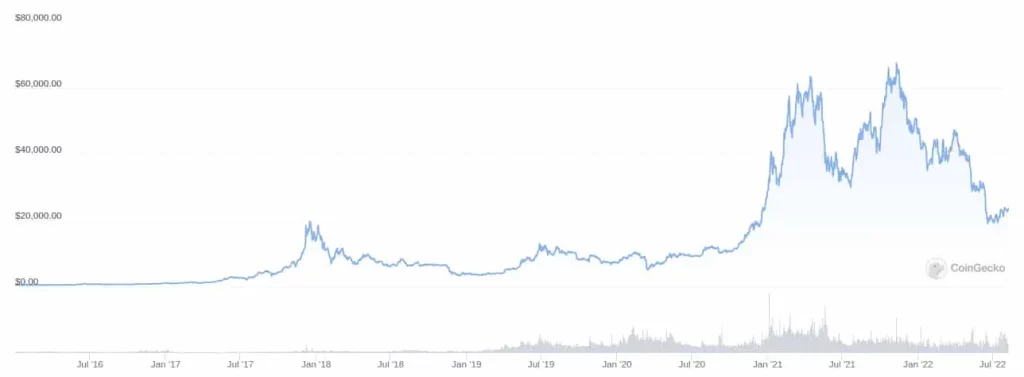
Besides Mt. Gox and Silk Road, there have been many other noteworthy points throughout Bitcoins history including:
- 31st October, 2008: Bitcoin Whitepaper is released under the pseudonym Satoshi Nakamoto
- 3rd January, 2009: First Bitcoin block was mined
- 22nd May, 2010: Bitcoin Pizza Day. One of the first Bitcoin transactions took place that was an economic trade. Two Papa John’s pizzas that cost around $25 at the time, were bought with 10,000 bitcoins
- 2010: Crypto Exchanges launched, including Mt. Gox which at the time handled over 70% of transactions for all Bitcoin users
- 2011: Bitcoin started growing exponentially with the Bitcoin price going from around $1 to $32 before crashing back to $2. Other cryptocurrencies such as Ethereum were also created
- October, 2012: BitPay announces that it has over 1,000 merchants accepting bitcoin
- 2013: Universities and many businesses such as Overstock.com, OkCupid and Foodler begin accepting bitcoin
- February, 2014: The Mt Gox exchange ceases operation and files for bankruptcy after losing hundreds of millions of dollars worth of its customers bitcoins
- February, 2015: Over 100,000 merchants globally accept bitcoins
- 2016: Over 700 Bitcoin ATMs are deployed globally
- June, 2017: The symbol for Bitcoin ₿ is officially encoded in the Unicode version 10.0
- 2020: Multiple multi-billion dollar companies turn to Bitcoin as a hedge against the US Dollar
- 9th June, 2021: The world first country, El Salvador, announces that they have approved law making Bitcoin legal tender
In Bitcoin’s relatively short history so far, its growth has been extremely fast relative to other new technologies. It is even managing to outpace the growth of the Internet itself and seems to be taking hold in developing countries first rather than how most new technologies evolve, which is going from rich to poor countries over time.
New to Athena Alpha? Start today!
Bitcoin Forks
Bitcoin is simply software and ever since it was created, many software developers have also tried to hard fork Bitcoin for various reasons. A Bitcoin Fork is when the code that runs the Bitcoin network is changed in one way or another. This changed code becomes its own “branch” that’s forked off from the main “tree” of the previous code.
These changes result in a new set of rules for all the nodes that make up the Bitcoin Network and also impacts the Blockchain. Sometimes these forks were to fix perceived flaws in the code, while other times it was for purely selfish reasons. Only two very minor Bitcoin hard forks have ever succeeded, these were:
- BIP-0050 (2013)
- CVE-2018-17144 (2018)
In contrast, here are just some of the dozens of failed Bitcoin hard forks:
- Bitcoin XT (2014)
- Bitcoin Classic (2016)
- Bitcoin Unlimited (2016)
- Bitcoin Diamond (2017)
- Bitcore (2017)
- Bitcoin God (2017)
- Super Bitcoin (2017)
- Bitcoin Cash (2017)
- Bitcoin Gold (2017)
- Bitcoin Private (2018)
- Bitcoin Atom (2018)
- Bitcoin Zeo (2018)
- Bitcoin Post-Quantum (2018)
- Bitcoin Satoshi’s Vision (2018)
The Blocksize Wars
As noted above, Bitcoin XT was the first major hard fork that Bitcoin ever saw. Developed by Mike Hearn, he proposed a number of new features with the most notable one being an increase to the Bitcoin Blockchain block size. Originally set at 1 MB by Satoshi Nakamoto, he wanted to increase it to 8 MB in order to increase the number of Bitcoin transactions per second that the Blockchain could handle.
This effectively started what many call The Blocksize Wars with many later hard forks trying to essentially do the same thing. While there’s nothing wrong with having faster transactions, if the size of blocks is increased then this in tern increases the size of the Bitcoin Blockchain.
As the entire blockchain needs to be downloaded and stored on all Full Bitcoin Nodes, the bigger it is, the more costly a Bitcoin Node becomes. Seemingly small increases in the block size can result in huge and expensive requirements for node runners which decreases the decentralization and security of the entire network. For example, a block size of 128 MB could result in the blockchain growing at a rate of 6.5 TB per year!
| Bitcoin | Bitcoin Cash | Bitcoin SV | |
|---|---|---|---|
| Purpose | Trustless Money | Trustless Money | Trustless Money |
| Symbol | BTC | BCH | BSV |
| Creators | Satoshi Nakamoto | Developers | Craig Wright, Calvin Ayre |
| Launched | Jan-2009 | Aug-2017 | Nov-2018 |
| Consensus | Proof-of-Work (SHA-256) | Proof-of-Work (SHA-256) | Proof-of-Work (SHA-256) |
| Block Size | 1 MB -> 4 MB | 8 MB -> 32 MB | 128 MB -> 2 GB -> Infinite |
| Block Time | 10 min | 10 min | 10 min |
| Transactions | 7/sec | 116/sec | 50,000/sec |
| Supply | 21 Million BTC | 21 Million BCH | 21 Million BSV |
After Bitcoin XT died off into irrelevance over a few months, other developers tried other hard forks such as Bitcoin Classic in 2016, Bitcoin Cash and Bitcoin SV. All of these similarly tried to change the blockchain technology to allow for faster cryptocurrency transactions with all of them failing.
Bitcoin’s Price History
Throughout all this history Bitcoin has gone through a number of huge bear and bull markets. From gaining almost 3,000% in just three months to loosing almost 40% in one day it has been – and still is! – a wild ride for investors.
The tables values are taken from CoinGecko.com and is reliable for the 2013 period onwards, however in the earlier years of 2009 to 2013, valuations were difficult to pin down given its immature market.
| Year | Start | End | Return |
|---|---|---|---|
| 2009 | $0 | $0 | 0% |
| 2010 | $0.0025 | $0.10 | 3,900% |
| 2011 | $1 | $30 | 2,900% |
| 2012 | $5.31 | $14 | 164% |
| 2013 | $20 | $755 | 3,675% |
| 2014 | $767 | $317 | -59% |
| 2015 | $314 | $431 | 37% |
| 2016 | $434 | $960 | 121% |
| 2017 | $998 | $14,839 | 1,387% |
| 2018 | $14,093 | $3,809 | -73% |
| 2019 | $3,692 | $7,240 | 96% |
| 2020 | $7,244 | $28,837 | 298% |
| 2021 | $28,665 | $48,022 | 67% |
| 2022 | $48,082 | $16,540 | -66% |
| 2023 | $16,541 | $42,208 | 155% |
| 2024 | $42,208 |
Volatility & Bitcoin Trading
Key to the bitcoin trading markets as well as the narrative surrounding bitcoin itself has been Bitcoin volatility. While some wrongly assume that it’s just a fundamental part of Bitcoin, the volatility is actually a known issue seen in any asset that has a small Market Cap.
Assets that aren’t very big can be easily influenced by large buyers or sellers which increases volatility in the asset. As such, it’s expected that once the market cap of Bitcoin increases to multiple trillions of dollars that we’ll see this volatility essentially disappear.
This volatility, especially in the earlier stages of Bitcoins history, has seen a huge amount of bitcoin trading. From bitcoin futures to tens of thousands of other digital currencies, digital assets and their movements up and down have been an ever present news topic throughout bitcoins history.
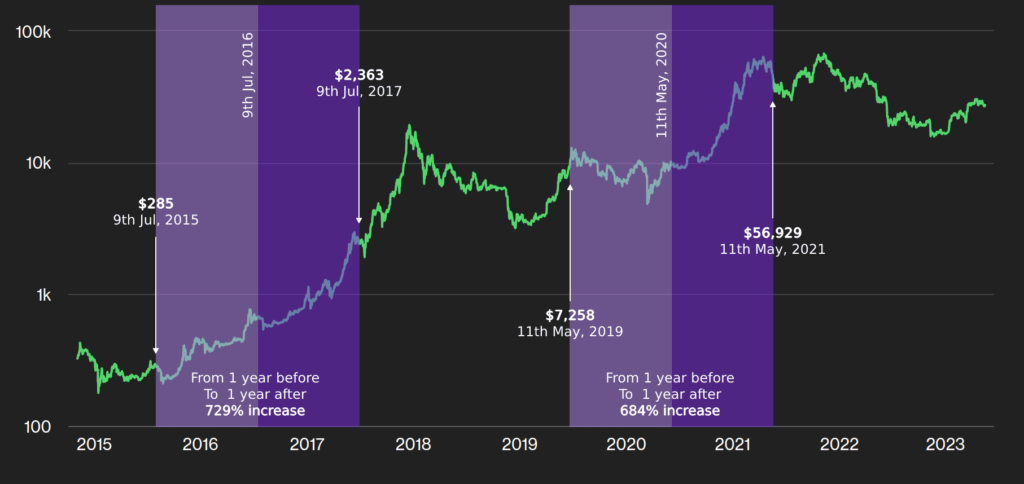
Another big factor that’s encouraged trading and this volatility are the regular Bitcoin Halvings that take place roughly every 4 years. These cut in half the reward that Bitcoin Miners receive for mining bitcoin and contribute to a severe supply shock which then goes on to (usually) increase the price of bitcoin.
Over the years we’ve also seen a number of questionable and out right illegal Bitcoin Scams and other digital currency networks emerge. From Ethereum to Dogecoin, these alternate digital currency blockchains have all tried to “be the next Bitcoin”, but have never quite been able to fully capture the market.
After Ethereum, Initial Coin Offerings (ICOs) began to run rampant with venture capitalists funding huge numbers of new altcoins to compete with and supposedly replace the “old” and outdated Bitcoin. These ICOs, whilst being around earlier, mainly gained popularity during the huge 2017 bull run.
Throughout 2017 their growth dwarfed anything else that had come before with companies raising unbelievable sums of money in seconds. For example, Brave Browser launched with their BAT token and raised over $35 million dollars in just 30 seconds while Filecoin in Janurary 2018 raised over $200 million within the first hour of their token sale.
While there were some legitimate launches via ICOs, the overwhelming majority ended up being huge pump and dump schemes with millions of retail investors unwittingly becoming the Exit Liquidity for rich investors. With such huge sums of money and scams running rampant, ICOs quickly drew the attention of government bodies like the SEC.
Due to this new risk of being investigated and punished by the SEC, together with the severe bear market that followed in 2018, ICOs have largely been stopped.
The Lightning Network
The Bitcoin Lightning Network is a decentralized network of nodes that sits on top of the base, Bitcoin Network. In Feb 2015, Joseph Poon and Tadge Dryja started working on the Lightning Network and in Jan 2016 released the Lightning Network Whitepaper. Shortly after Lightning Labs released a beta version for testing and it has only grown since then.
This Layer 2 network as it’s often called allows for instant, near zero fee, high volume micropayments all without having to involve trusted third parties like banks or payments processor like Visa or Master Card.
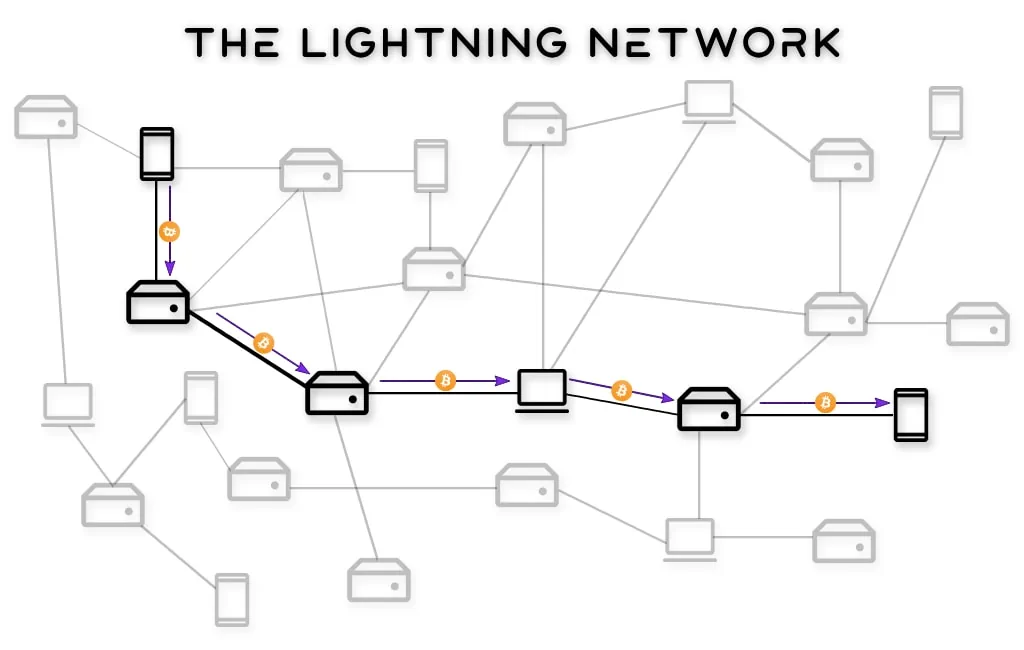
The Lightning Network is made up of thousands of privately owned nodes and wallets. Each node opens one or more Lightning Channels with other nodes allowing them to send and receive payments too each other near instantly.
Since its creation and huge growth over the past few years, its effectively quelled any further suggestions of “increasing block sizes” like what was seen during the Blocksize Wars in 2014. While not immediately obvious to everyone when they start studying Bitcoin, the Lightning Network seems like it will be instrumental in enabling Bitcoin to achieve its original goal of becoming a true Peer to Peer Electronic Cash System.
FAQ
How Much Is 1 Bitcoin In 2009?
2009 was the year Bitcoin started so it was still very much an unknown, experimental project at this time. As such, it wasn’t actively traded by anyone and thus, never had “a price” back then. The first time a value was given was in 2010 at around $0.0025 per bitcoin.
When Was Bitcoin At $1?
In the earlier years of 2009 to 2013, Bitcoin valuations are difficult to pin down as it was still an immature market, but roughly speaking Bitcoin was first valued at around $1 USD at the start of 2011.
How Much Would I Have If I Invested $1000 In Bitcoin In 2010?
In 2010 Bitcoin was traded at roughly $0.0025 – $0.10 USD per bitcoin. Thus if you invest $1,000 USD you would have between 400,000 – 10,000 bitcoin now valued at $11.2 billion – $280 million dollars assuming 1 bitcoin is valued at $28,000.
How Much Was 1 Bitcoin In 2008?
As the very first Bitcoin block wasn’t mined by Satoshi until 3rd of January, 2009, Bitcoin itself didn’t exist at all in 2008 and so was not worth anything.
When Was Bitcoin Under $1?
Bitcoin traded under $1 USD for all of 2009 and 2010. It wasn’t until the start of 2011 that it broke through the $1 USD per bitcoin mark.
When Was Bitcoin $1,000?
Bitcoin traded above $1,000 USD for the first time in 2017. Throughout the year it went from $998 all the way up to $14,839 in what was one of its biggest ever bull runs.

